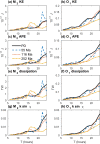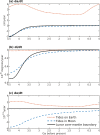Long-Term Earth-Moon Evolution With High-Level Orbit and Ocean Tide Models
- PMID: 35846556
- PMCID: PMC9285098
- DOI: 10.1029/2021JE006875
Long-Term Earth-Moon Evolution With High-Level Orbit and Ocean Tide Models
Abstract
Tides and Earth-Moon system evolution are coupled over geological time. Tidal energy dissipation on Earth slows rotation rate, increases obliquity, lunar orbit semi-major axis and eccentricity, and decreases lunar inclination. Tidal and core-mantle boundary dissipation within the Moon decrease inclination, eccentricity and semi-major axis. Here we integrate the Earth-Moon system backwards for 4.5 Ga with orbital dynamics and explicit ocean tide models that are "high-level" (i.e., not idealized). To account for uncertain plate tectonic histories, we employ Monte Carlo simulations, with tidal energy dissipation rates (normalized relative to astronomical forcing parameters) randomly selected from ocean tide simulations with modern ocean basin geometry and with 55, 116, and 252 Ma reconstructed basin paleogeometries. The normalized dissipation rates depend upon basin geometry and rotation rate. Faster Earth rotation generally yields lower normalized dissipation rates. The Monte Carlo results provide a spread of possible early values for the Earth-Moon system parameters. Of consequence for ocean circulation and climate, absolute (un-normalized) ocean tidal energy dissipation rates on the early Earth may have exceeded rate due to a closer Moon. Prior to , evolution of inclination and eccentricity is dominated by tidal and core-mantle boundary dissipation within the Moon, which yield high lunar orbit inclinations in the early Earth-Moon system. A drawback for our results is that the semi-major axis does not collapse to near-zero values at 4.5 Ga, as indicated by most lunar formation models. Additional processes, missing from our current efforts, are discussed as topics for future investigation.
Keywords: Earth rotation; Earth‐Moon history; lunar orbit; ocean tides; plate tectonics.
© 2021. The Authors.
Figures











References
-
- Adams, C. , Miller, H. , Toselli, A. , & Griffin, W. (2008). The Puncoviscana Formation of northwest Argentina: U‐Pb geochronology of detrital zircons and Rb‐Sr metamorphic ages and their bearing on its stratigraphic age, sediment provenance and tectonic setting. Neues Jahrbuch für Geologie und Paläontologie ‐ Abhandlungen, 247, 341–352. 10.1127/0077-7749/2008/0247-0341 - DOI
-
- Arbic, B. K. , Alford, M. H. , Ansong, J. K. , Buijsman, M. C. , Ciotti, R. B. , Farrar, J. T. , et al. (2018). A primer on global internal tide and internal gravity wave continuum modeling in HYCOM and MITgcm. In Chassignet E. P., Pascual A., Tintore J., & Verron J. (Eds.), New frontiers in operational oceanography (pp. 307–392). GODAE OceanView. 10.17125/gov2018.ch13 - DOI
-
- Arbic, B. K. , & Garrett, C. (2010). A coupled oscillator model of shelf and ocean tides. Continental Shelf Research, 30, 564–574. 10.1016/j.csr.2009.07.008 - DOI
-
- Arbic, B. K. , Garner, S. T. , Hallberg, R. W. , & Simmons, H. L. (2004). The accuracy of surface elevations in forward global barotropic and baroclinic tide models. Deep Sea Research Part II: Topical Studies in Oceanography, 51, 3069–3101. 10.1016/j.dsr2.2004.09.014 - DOI
-
- Arbic, B. K. , Karsten, R. H. , & Garrett, C. (2009). On tidal resonance in the global ocean and the back‐effect of coastal tides upon open‐ocean tides. Atmosphere‐Ocean, 47, 239–266. 10.3137/OC311.2009 - DOI
